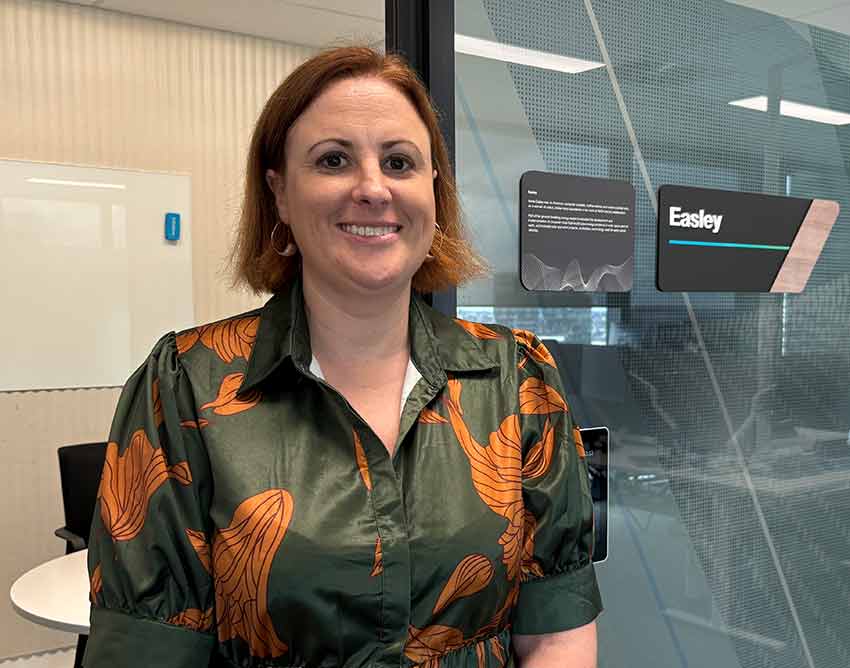
The energy industry has been shaped by numerous trailblazers, and while most people are familiar with names like Edison, Tesla, Volta, and Watt – and their inventions – fewer people recognise the groundbreaking contributions made by Clarke, Easley, and Telkes.
Edith Clarke, Annie Easley, and Maria Telkes – whom CS Energy has meeting rooms named after – advanced energy technology and paved the way for future generations of women in STEM fields.
CS Energy’s Head of Policy & Regulation Alison Demaria (pictured above) suggested the names to bring light to the contributions that women have made to the energy industry over time.
“From laying the groundwork for modern electrical engineering to harnessing the power of solar energy and advancing space-age technologies, these women defied societal expectations and reshaped the industry for generations to come,” Alison said.
“Their talent, determination, innovation, and resilience have left a legacy of work that wasn’t just groundbreaking – it was foundational for the modern energy industry.
“Recognising their impact isn’t just about honouring the past; it’s about inspiring the next wave of leaders who will redefine energy for a changing world.”
Edith Clarke: the electrical engineering pioneer
 Widely recognised as the first professional female electrical engineer, Edith Clarke was born in Maryland, USA in 1883 and orphaned at 12.
Widely recognised as the first professional female electrical engineer, Edith Clarke was born in Maryland, USA in 1883 and orphaned at 12.
Raised by her older sister, Clarke first studied mathematics and astronomy at Vassar College (1908), then taught mathematics and physics before leaving to study civil engineering – which she left to become a ‘computer’ at AT&T.
While there, she studied electrical engineering at Columbia University at night, and then became the first woman to earn a Master of Science degree in Electrical Engineering from MIT in 1919 with a thesis titled ‘Behaviour of a lumpy artificial transmission line as the frequency is indefinitely increased’.
Clarke’s most notable contributions were in the field of electrical power system analysis. While working at General Electric, she invented the Clarke Calculator, which simplifies complex equations that determine the electrical characteristics of long-distance power transmission lines – this was 10 times faster than other methods at the time, and reduced errors to less than one per cent.
She also worked on the design and analysis of Hoover Dam’s electrical power systems, particularly focusing on the turbines and transmission lines, ensuring the efficient generation and distribution of electricity from the project.
Clarke also taught physics at the Constantinople Women’s College in Turkey for a year while on leave from GE, and was later the first female professor of electrical engineering at the University of Texas (Austin).
Image: Engineering and Technology History Wiki
Annie Easley: the NASA trailblazer
_850px.jpg) Born in 1933, Annie Easley was an African American computer scientist and mathematician who made significant contributions to NASA's rocket systems and energy technologies.
Born in 1933, Annie Easley was an African American computer scientist and mathematician who made significant contributions to NASA's rocket systems and energy technologies.
Starting her career in 1955 as a ‘human computer’ for the National Advisory Committee for Aeronautics (NACA - which later became NASA), Easley taught herself programming languages like Fortran and SOAP to run simulations and develop computer code for various NASA projects.
Easley's work was instrumental in researching and analysing alternative power technologies, including batteries and fuel systems for hybrid vehicles and the Centaur upper-stage rocket – the first rocket stage to use liquid hydrogen and liquid oxygen as propellants.
Annie had started her higher education studying pharmacy for about two years; she returned to school later in life to earn a Bachelor of Science in Mathematics from Cleveland State University while working full-time at NASA, graduating in 1977.
Image: NASA
Maria Telkes: the Sun Queen
Often referred to as ‘the Sun Queen’, Maria Telkes was a pioneer in solar energy research and development.
 Born in Hungary in 1900, she earned her PhD in physical chemistry at the University of Budapest in 1924, and moved to the USA the following year, where she began her work in harnessing solar energy.
Born in Hungary in 1900, she earned her PhD in physical chemistry at the University of Budapest in 1924, and moved to the USA the following year, where she began her work in harnessing solar energy.
Telkes developed innovative processes for capturing and deploying solar energy, including one of the first successful solar ovens and a solar water distillation system which converted seawater into drinkable water – a life-saving device used by pilots and sailors stranded in the Pacific during World War 2.
She was also involved in the development of an experimental project called the Dover Sun House, which was the world’s first modern house to be heated with solar energy, in 1948.
Telkes designed an innovative heating system using salt as a thermal storage material: during the day, solar energy melted the salt and stored heat; and in the evening, the salt released the stored heat as it solidified, warming the house – a groundbreaking system at the time which inspired future advancements in solar technology.
Image: Library of Congress Prints and Photographs Division. New York World-Telegram and the Sun Newspaper Photograph Collection